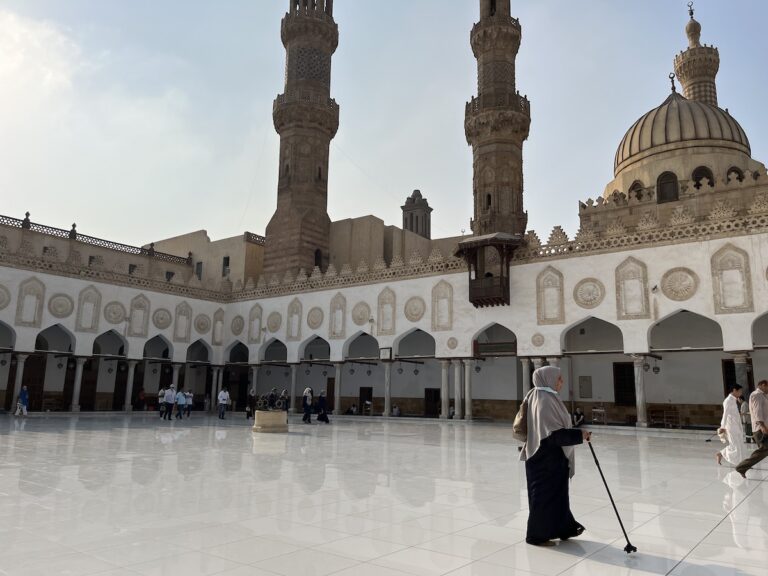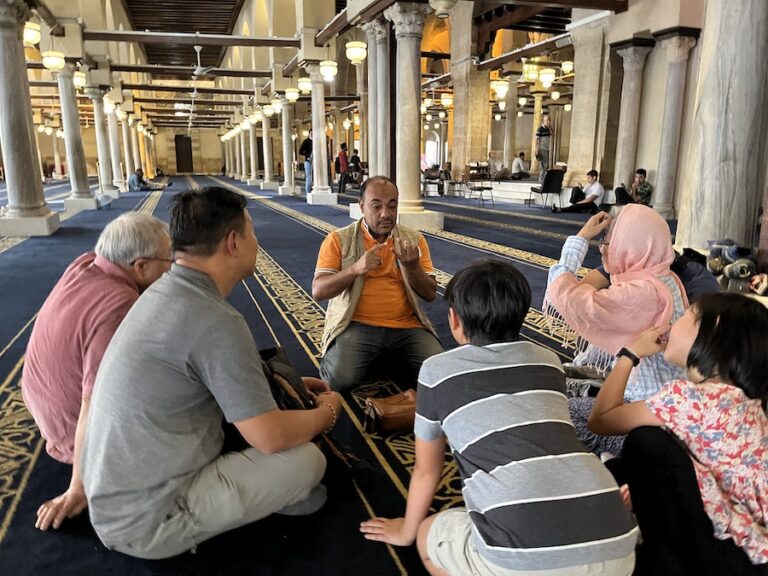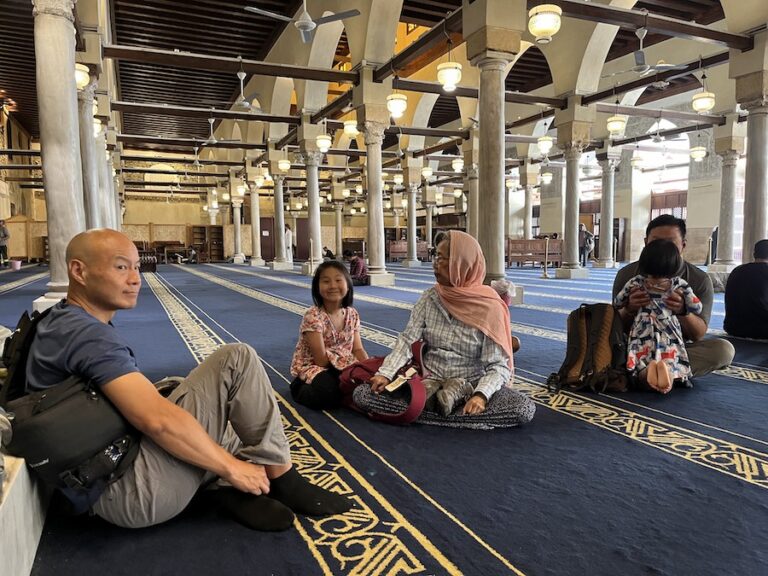During the Pharaonic times when Ancient Egyptians believed in a polytheistic religion with thousands of gods. Today, Egypt is nearly 90% Muslim. How and when did this change in religion take place?
It is fascinating to explore Egypt’s long history. It is a turbulent and every-changing complex history of invasion, times of peace and prosperity and ultimately change once again. The history of cultures and religions have blended together to create the rich tapestry that is the Egyptian civilization. There was a summary plaque at the entrance of the National Museum of Egyptian Civilization that we have referred to many times throughout our study of Egypt. It is a timeline of the history of Egypt that shows the various pharaonic dynasties and periods of rule by foreign invaders. I have simplified it so that the whole of Ancient Egypt is combined into one line and juxtaposed the years of rule to give us perspective of the duration of each period.
Ancient Egypt: 5500 – 332 BC (~5000 years)
Ptolemaic Period: 332 – 30 BC (~300 years)
Roman period: 30 BC – 395 AD (~360 years)
Byzantine Era: 330 – 641 (~300 years)
Islamic Era: 632 – 1517 (~900 years)
Ottoman Period: 1517 – 1805 (~300 years)
Muhammad Ali Dynasty: 1825 – 1952 (~125 years)
Republic: 1952 – present (~70 years)
The reign of Egyptian pharaohs (including Nubian and Libyan) ended in 332 BC, after which began the Ptolemaic Era that ended with Cleopatra in 30 BC. Octavian defeated the Egyptians, Cleopatra committed suicide and Egypt came under Roman dominion for the next 360 years until 395 AD. During Roman rule, Christianity was brought to Egypt. In 330, Emperor Diocletian divided the Roman Empire into two parts and Egypt became part of the eastern half, called the Byzantine Empire during which Egypt moved away from the polytheism of the ancient Egyptian religion to Coptic Christianity. The Arabs defeated the Byzantine Empire in the 7th century, which brought Egypt under Islamic rule around 632. By the 10th century, Islam had already become the dominant religion in Egypt. Today, 90% of the country is Muslim.
Al-Azhar Mosque is one of the most important mosques in Egypt. It is a center for both worshipping and learning about Islam. Al-Azhar Mosque was built in 972 AD, shortly after the founding of Cairo, during the Fatimid Caliphate. The Fatimids were Shias as the rulers claimed to be descendants of the Prophet Muhammad’s daughter, Fatima. The Mosque was originally built by the Shias but it later became a Sunni mosque in the 12th century. It is one of the earliest Jami complexes (mosque plus university) in the Muslim world. Currently, it is among the largest Islamic universities in the world and currently has over 2 million students, attracting students from all over the Islamic world.
At the entrance, women are requested to dress respectfully, meaning covered from head to toe. My arms were uncovered as I was wearing a t-shirt and part of my mom’s legs were uncovered as my mom was wearing pants that reached to her calf, so we were politely directed to the women’s area where we were lent appropriate attire that would cover whatever part that was exposed. A smiling young lady handed me a full-length abaya and my mom was given a long skirt. We pulled these over our own clothes and were ready to enter the courtyard.
We removed our shoes and entered the gleaming white marble courtyard. Before entering a mosque, Muslims perform ablutions, a purification ritual called Wudu. Wudu is a cleansing ritual of washing hands, mouth, nose, face, arms, hair, ears and feet. Since we are not Muslim, we didn’t need to perform Wudu.
The significance of Al-Azhar goes beyond its stunning white marble courtyard and three towering minarets built in 1340, 1469 and 1510. When we visited al-Azhar, it immediately felt different than other mosques I have visited. The mosque itself was huge and there were large tables at the back and sides of the mosque with bookshelves along the walls. It felt more like a university library than a house of worship. There were Muslims from all over the world, Egyptians, Africans, Arabs, Indonesians and Malaysians, talking, studying and praying. Men who not dressed in regular street clothes wore the Muslim-style dress in the style from their own country, usually some kind of tunic or robe with a kufi hat. Women were dressed conservatively with their bodies entirely covered, some wearing a hijab (head covering) or niqab (head covering plus veil). We saw a group seated on the floor surrounding an imam who appeared to be teaching a lesson.
We too, sat down in the middle of the mosque, and our guide, Iman, told us about the history of Al-Azhar and the five basic pillars of Islam.
1. Belief – Belief in Allah as the one and only God and Muhammad is his messenger.
2. Prayer – Pray 5 times each day, at least.
3. Alms – Give 2.5% of your total wealth to those in need.
4. Fasting – Fast one month of the year during the month of Ramadan.
5. Pilgrimage – Make the pilgrimage (Hajj) to Mecca once during lifetime if conditions allow.
Given the recent situation in the Middle East between Israel and Palestine, we had a lot of questions about the historical differences and tensions between Muslims, Christians and Jews. At this point, we heard the adhan, the call to prayer, but Iman patiently answered each of these questions and gave us a thoughtful and measured introductory lesson on the historical strife between Muslims, Christians and Jews, from his perspective, that of an Egyptian Muslim.
After he had answered all of our questions, Iman asked to excuse himself to pray. I was fascinated as I watched him walk a few steps away and complete the ritual of salat. He and every Muslim in the world, 1.8 million of them, do this five times a day. They all face Mecca and follow the same procedure – the motions and the recitations, to complete salat. Observing Iman and recognizing that at the same moment, millions of others stopped whatever they were doing to pray, helped me appreciate the powerful force of religion. Islam crosses nationalities, politics and culture, and unites almost one-quarter of the world’s population.
Our experience at al-Azhar encapsulates the reason why the best classroom is a classroom without walls. In one afternoon, we learned about Islam, its history and practices. We met and interacted with the followers of Islam. With our own eyes, we saw where Muslims worship and how they worship. With our own ears, we learned from a Muslim about his religion and the history of his religion. Using the newly acquired knowledge, we formed questions to develop a deeper understanding. We then applied our learning in a conversation to try and make sense of what is happening in the Middle East today.
Author
-

Song is the mother of four children. She and her family have stepped away from it all and in September 2023, began traveling the world while homeschooling. Song is an ABC (American born Chinese) and has an undergraduate degree from Cornell and an MBA from Harvard. She is an entrepreneur and an educator. Her hobbies include learning, traveling, reading, cooking and baking, and being with children.








11/13 愛資哈爾清真寺
愛資哈爾清真寺,法蒂瑪王朝大寺。
最古伊斯蘭大學,宗教學術集於斯。
法蒂瑪王朝知否?綠衣大食史書有。
五代十國時中國,阿拉伯帝國春秋。
法蒂瑪奉什葉派,十二世紀王朝敗。
庫德英雄薩拉丁,恢復埃及遜尼派。
古埃及宗教憑弔,伊斯蘭教成國教,
百分九十遜尼派,聖訓遵守最重要。
虔誠教徒穆斯林,一天五次禮拜勤。
麥加方向誠敬拜,阿拉真主信滿心。